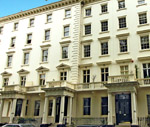Prime London market booming
Top end property in London is outperforming the rest of the country as British buyers and overseas investors aim for different parts of the market


As the lead-up to the Olympics gathers pace, the top end of the London property market is booming. Knight Frank report that luxury properties in the capital have seen a 24% price increase since their post-credit-crunch low in March 2009, and Savills quote a 4.6% annual rise in prime London values in 2010 compared with the Nationwide's figure for the mainstream UK market of just 0.4%.
Overseas buyers and investors are playing a large role in underpinning demand for luxury homes: London is still seen as a safe haven for investment, and the exchange rate continues to favour the Euro. According to Savills, foreign buyers accounted for 53% of all prime central London property purchases in the past two years, growing from 45% in the preceding three years, and were even more active in the super-prime market.
By contrast, British buyers are driving demand for good family houses in areas such as Richmond, Wandsworth and Barnes. This is having a positive effect on local prices-prime south-west London saw a 7.8% increase in 2010, and is virtually back to peak levels. Those who can't find the right property to buy are renting instead-rents for upmarket London properties rose by 1.5% during the final quarter of 2010, putting annual growth at a massive 11.5% and nearly bridging the gap with the March 2008 peak.
Although prime and super-prime properties are out-performing the rest of the market, and family houses are in short supply, another significant slice of the London market is the pied à terre-a one- or two-bedroom flat used as a base during the week by those whose primary residence is in the country. Again, demand for this kind of property is mostly powered by British buyers.
‘This is a very large part of the market from South Kensington into Chelsea, Marylebone, Bayswater and Fitzrovia, and even into the Barbican,' explains Liam Bailey of Knight Frank. Indeed, in Tower Bridge, Chesterton Humberts reports that 28% of all sales in 2010 were to pied à terre buyers. The reasoning behind these purchases is sound: you limit frustrating and expensive commutes while making a good long-term investment. These flats are also useful for children who need a place to stay when in town, and as a base for shopping expeditions (a Kensington and Chelsea parking permit is a particular bonus).
Most pied à terre buyers have a budget of £500,000 to £800,000, and are looking for a one- or two-bedroom property that has easy access to both the office and the country house. ‘The convenience of the location takes precedence over almost anything else,' Mr Bailey says. Jonathan Hewlett at Savills agrees, adding that he's seen an increasing number of people looking to walk to work: ‘People are walking more, and further. A half-hour walk along the river is much more pleasant than braving the Tube.'
Pied à terre buyers tend to opt for a first- or second-floor flat in a smart period terraced house in central west London. Pimlico is a particularly popular choice Douglas and Gordon (020-7931 8200) have an elegant flat on Warwick Square currently arranged as a one-bedroom (with a study/second bedroom) for £895,000. South Kensington also fits the bill of convenient locations. Here, Knight Frank (020-7349 4300) are selling a one-bedroom flat with fabulous views over Evelyn Gardens for £625,000 (leasehold; the extension of the lease would cost about £225,000-£250,000).
Exquisite houses, the beauty of Nature, and how to get the most from your life, straight to your inbox.
New-build apartments aren't generally as popular among pied à terre buyers, chiefly because they're expensive. Instead, developments such as NEO Bankside, by Tate Modern, which are being built to extremely exacting specifications with price tags to match, tend to appeal more to investors and foreign buyers.
Double renters hold onto London equity
Double renters are either young families who let their London house to rent in the country, usually to be close to a desirable school in their chosen area prior to buying, or downsizers renting out their country house and moving into a smaller country property, or back to the capital. For the former group, letting their London house is a great way to hold onto the equity over time, and for the latter, it's a perfect way to adjust to a different pace of life while keeping all the options open.
For those renting out London houses, the property needs to meet the high standards of the international business community, which demands managed properties set in central locations. Those letting out their country house find that good schools drive the majority of the demand in the Home Counties.
-
 Child stars, Prince and nursery rhymes: It's the Country Life Quiz of the Day, December 5, 2025
Child stars, Prince and nursery rhymes: It's the Country Life Quiz of the Day, December 5, 2025It's all in today's quiz.
By Country Life Published
-
 ‘Calf’s brains have a bland, gentle richness that soothes and cossets': Tom Parker Bowles on the joys of eating offal
‘Calf’s brains have a bland, gentle richness that soothes and cossets': Tom Parker Bowles on the joys of eating offalEating offal it is more sinned against than sinning, but it offers the ultimate in magnificent, fully immersive eating.
By Tom Parker Bowles Published

